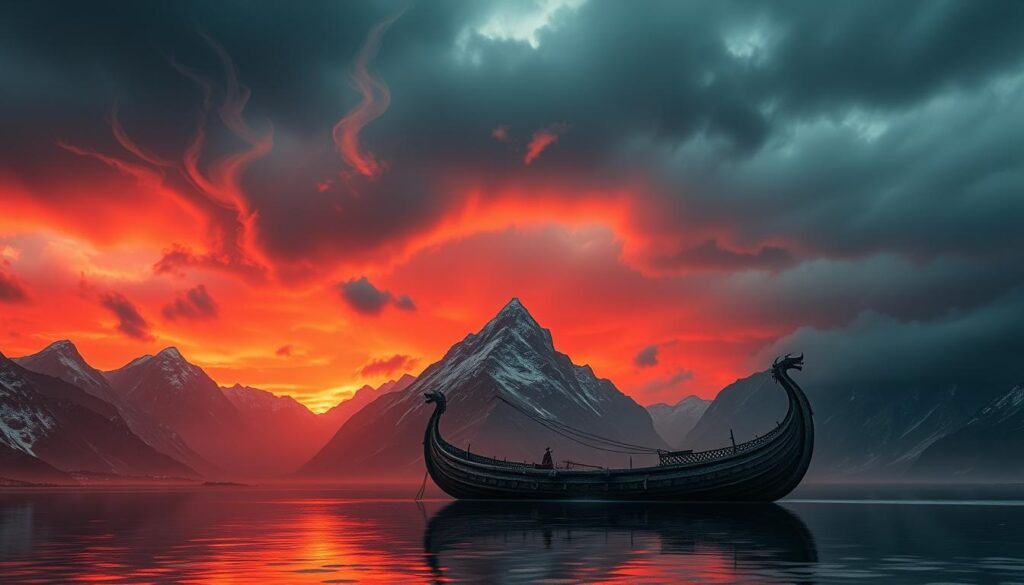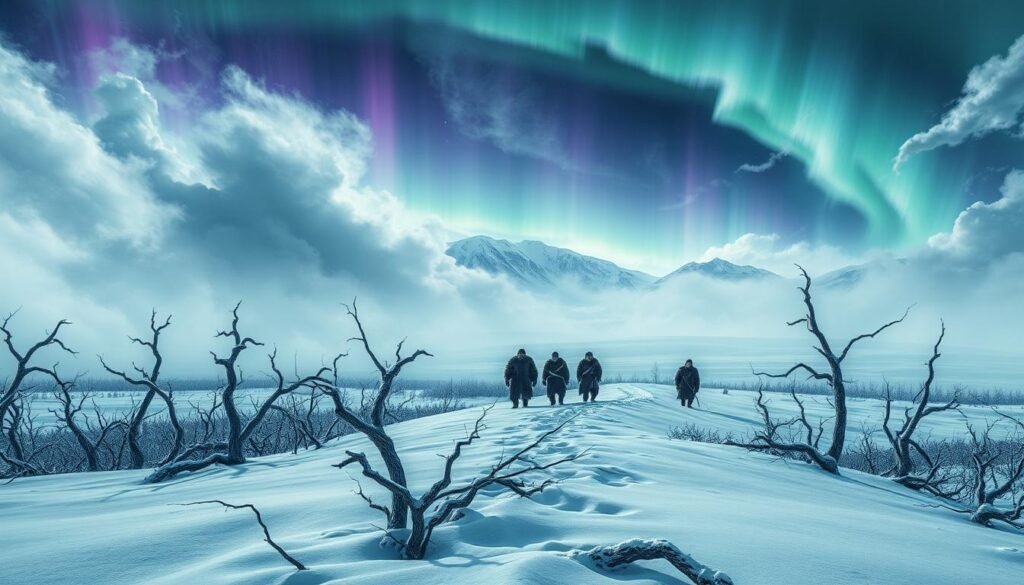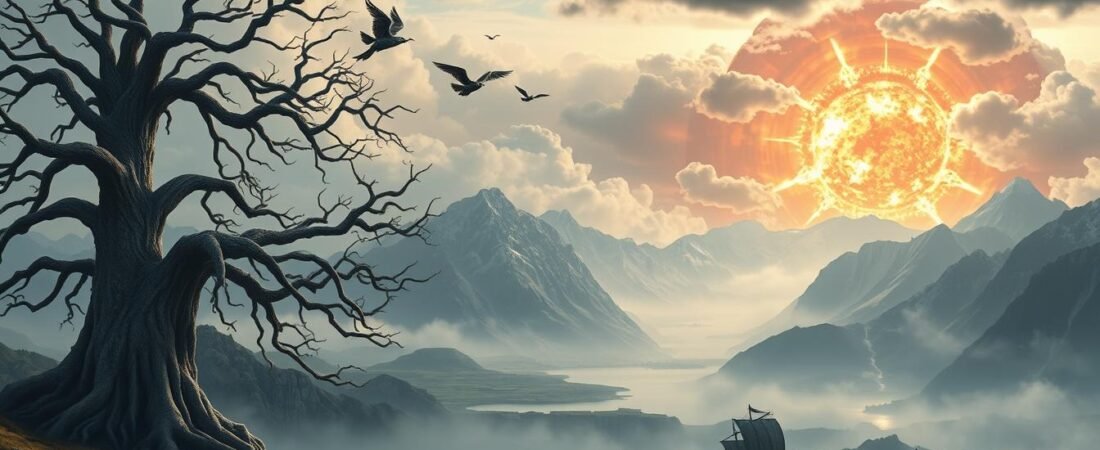The apocalyptic event known as Ragnarök has captivated imaginations for centuries, representing the end of the world in Norse mythology. This cataclysmic series of events is not just a simple tale of destruction; it’s a complex narrative filled with gods, giants, and supernatural beings.
The significance of Ragnarök lies in its representation of the cyclical nature of time, where the world is reborn after destruction. This mythology has inspired countless works of art, literature, and popular culture, continuing to fascinate audiences worldwide.
Key Takeaways
- Understanding Ragnarök’s role in Norse mythology.
- The significance of the apocalyptic event.
- Exploring the characters involved in Ragnarök.
- The impact of Ragnarök on modern culture.
- The cyclical nature of time in Norse mythology.
The Cosmic Twilight: Understanding Ragnarök in Norse Mythology
In the realm of Norse mythology, Ragnarök represents a cosmic twilight where gods and giants clash. This cataclysmic event is foretold to bring about the end of the world and the downfall of the gods.

Etymology and Meaning of Ragnarök
The term Ragnarök is derived from Old Norse, with “ragna” meaning gods and “rök” signifying twilight or end. Thus, Ragnarök translates to the twilight of the gods, symbolizing their downfall.
According to the Poetic Edda and the Prose Edda, two medieval Icelandic manuscripts, Ragnarök is a series of events leading to the world’s demise.
Historical Sources and Literary Origins
The primary sources for understanding Ragnarök are the Poetic Edda and the Prose Edda. These texts provide insights into the Norse eschatological beliefs and the mythology surrounding the end times.
The literary origins of Ragnarök are deeply rooted in Viking Age oral traditions, later compiled into the Eddas.
The Nine Worlds of Norse Cosmology
Norse cosmology is characterized by the existence of nine worlds, including Asgard, the realm of the gods, and Midgard, the world of humans. These worlds are interconnected by the World Tree, Yggdrasil.
Understanding the Nine Worlds is crucial for grasping the events of Ragnarök, as the fate of each world is intertwined.
The Fimbulwinter: Harbingers of the End Times
As the cosmos teeters on the brink of collapse, the Fimbulwinter emerges as a pivotal precursor to the Norse apocalypse. This period is characterized by three consecutive winters with no intervening summer, marking a significant departure from the natural order.

Three Years of Endless Winter
The Fimbulwinter is a harbinger of doom, lasting for three years without a break. This prolonged winter is not just a climatic anomaly but a sign of the impending chaos that will soon engulf the nine worlds.
During this period, the usual cycles of nature are disrupted, setting the stage for the catastrophic events that follow.
Moral Decay and Social Collapse
As the Fimbulwinter takes hold, societal norms begin to fray, and moral decay sets in. The harsh conditions lead to a breakdown in social cohesion, as individuals become more focused on survival than communal well-being.
This erosion of social bonds is a critical aspect of the Fimbulwinter, as it weakens the fabric of society, making it more vulnerable to the impending disasters.
The Breaking of Familial Bonds
The Fimbulwinter also witnesses the breaking of familial bonds, as the struggle for survival becomes paramount. The usual ties that bind families together begin to unravel, leading to a further destabilization of society.
| Aspect | Description | Impact |
|---|---|---|
| Climatic | Three consecutive winters | Disruption of natural cycles |
| Social | Moral decay and social collapse | Breakdown of societal norms |
| Familial | Breaking of familial bonds | Destabilization of family structures |
Prophecies and Portents: Signs of Ragnarök’s Approach
The Poetic Edda is replete with prophecies that signal the coming of Ragnarök, a cataclysmic event in Norse mythology. These ancient texts provide a glimpse into the beliefs of the Norse people, who were deeply concerned with the end times and the fate of their gods.
The Völuspá’s Warnings
The Völuspá, a poem within the Poetic Edda, offers a detailed account of the events leading up to Ragnarök. It speaks of a series of natural disasters and moral decay that precede the final battle. The Völuspá warns of the breaking of bonds and the release of monstrous forces that will ravage the nine worlds.
The Prophecy of the Seeress
A seeress, as described in the Völuspá, plays a crucial role in foretelling the events of Ragnarök. Her prophecy includes the death of gods and the destruction of the world, but also hints at a rebirth from the ashes. This cyclical understanding of time is characteristic of Norse cosmology.
Archaeological Evidence of Ragnarök Beliefs
Archaeological findings have provided evidence that supports the existence of beliefs surrounding Ragnarök in ancient Scandinavian cultures. Artifacts and inscriptions often depict scenes that mirror the mythological narratives, underscoring the significance of these stories in the daily lives and spiritual practices of the Norse people.
| Signs | Description | Significance |
|---|---|---|
| Fimbulwinter | Three years of endless winter | Precursor to Ragnarök, signaling the breakdown of natural order |
| Moral Decay | Breakdown of social and familial bonds | Indicates the approaching end times |
| Release of Monstrous Forces | Fenrir and Jörmungandr breaking free | Directly leads to the final battle of Ragnarök |
The prophecies and portents associated with Ragnarök highlight the complex and deeply intertwined nature of Norse mythology. Understanding these elements provides insight into the cultural and religious beliefs of ancient Scandinavian societies.
Ragnarök Rising: Norse End-Time Prophecies Explained!
As the fabric of Norse cosmology begins to unravel, the events leading to Ragnarök start to unfold. This cataclysmic series of events is deeply rooted in Norse mythology, foretelling the downfall of gods and mortals alike.
The Breaking of Cosmic Bonds
In Norse mythology, the breaking of cosmic bonds is a pivotal event signaling the onset of Ragnarök. The binding of Fenrir, a monstrous wolf, by the gods is a crucial mythological tale. The gods, aware of Fenrir’s destiny to devour the sun during Ragnarök, bound him using magical chains. However, as Ragnarök approaches, these bonds are broken, releasing Fenrir to fulfill his fate.
The liberation of Fenrir symbolizes the collapse of the cosmic order, marking the beginning of the end times. This event is intertwined with the release of other monstrous forces, heralding a period of unprecedented destruction.
The Release of Monstrous Forces
The release of monstrous forces is a hallmark of Ragnarök. Jörmungandr, the Midgard Ser serpent, and Fenrir are among the most fearsome creatures unleashed during this period. Jörmungandr, being the son of Loki, is a giant serpent encircling the world, ready to unleash havoc as the cosmic bonds are broken.
The emergence of these monstrous entities signifies the chaos and destruction that pervades the Nine Worlds during Ragnarök. Their release is a direct consequence of the breaking of cosmic bonds, leading to a catastrophic confrontation between the gods and these fearsome beings.
The Role of Fate and Wyrd in Norse Eschatology
In Norse mythology, fate and Wyrd play a significant role in the unfolding of Ragnarök. Wyrd, or fate, is an inexorable force that governs the destiny of gods and mortals. The Norns, three giant beings, are believed to shape the destiny of all beings, including the gods.
The concept of Wyrd underscores the inevitability of Ragnarök, suggesting that even the gods are not immune to the forces of fate. This eschatological narrative emphasizes the cyclical nature of Norse cosmology, where destruction is followed by rebirth.
Gods and Giants: Key Players in the Final Battle
As the cosmos teeters on the brink of destruction, the gods and giants prepare for their final confrontation in the epic battle of Ragnarök. This cataclysmic event is not just a random act of chaos; it’s the culmination of a complex web of fate and destiny that involves the most powerful beings in Norse mythology.
The Æsir and Their Fated Roles
The Æsir gods, including Odin, Thor, and Heimdall, are central to the events of Ragnarök. Each of these gods has a fated role to play in the final battle:
- Odin, the All-Father, leads the gods into battle, armed with his spear Gungnir.
- Thor, the god of thunder, fights against the giant serpent Jörmungandr.
- Heimdall, the vigilant guardian, stands ready to sound the alarm on his Gjallarhorn.
These gods are not just passive participants; they are actively engaged in the struggle against the forces of destruction.
Loki, Fenrir, and Jörmungandr: Agents of Destruction
On the other side of the conflict are the giants and monsters who serve as agents of destruction. Loki, the trickster god, is often counted among these forces due to his complex and conflicted role:
- Fenrir, the giant wolf, is destined to devour the sun and kill Odin.
- Jörmungandr, the Midgard Serpent, engages Thor in a fatal duel.
- Loki’s actions contribute to the chaos, though his ultimate allegiance is ambiguous.
These beings embody the destructive forces that the Æsir gods must confront.
Heimdall, Thor, and Odin: Defenders of Asgard
The defenders of Asgard are resolute in their determination to protect their realm. Heimdall and Loki engage in a fatal duel, while Thor ultimately succumbs to the venom of Jörmungandr after slaying the serpent. Odin’s confrontation with Fenrir ends in tragedy as the wolf fulfills his destiny by killing the All-Father.
In conclusion, the final battle of Ragnarök is a complex interplay of fate, destiny, and the actions of gods and giants. Understanding the roles of these key players provides insight into the Norse apocalyptic vision and its enduring power.
The Twilight of the Gods: How Ragnarök Unfolds
As the cosmos teeters on the brink of destruction, the events of Ragnarök unfold with catastrophic precision. This Norse apocalypse is not just a tale of the end of the world; it’s a complex narrative involving gods, giants, and mortals in a final, decisive confrontation.
The Great Battles and Divine Deaths
The final battle of Ragnarök is a clash of titans, with the gods and goddesses of Asgard facing off against their arch-nemesis, the giants. Odin, the All-Father, leads the charge, but he is ultimately consumed by Fenrir, the monstrous wolf. Thor, the god of thunder, manages to slay Jörmungandr, the Midgard Serpent, but succumbs to its venom. These divine deaths signify the end of an era, as the very fabric of the Norse cosmos begins to unravel.
Surtr’s Fire and World Conflagration
As the battles rage on, Surtr, the fire giant, emerges from the south, his flames engulfing the world. The fire spreads, consuming everything in its path, and the world is plunged into a fiery abyss. This world conflagration is not just a destructive force; it’s a transformative one, paving the way for rebirth from the ashes.
The Sinking of Midgard
In the end, the earth sinks into the sea, and the stars vanish from the sky. The once-mighty world of Midgard is no more, lost to the cataclysmic events of Ragnarök. Yet, even in destruction, there is a promise of renewal, as the cycle of Norse cosmology continues, awaiting the emergence of a new world from the ruins.
Rebirth from Ruin: The World After Ragnarök
The aftermath of Ragnarök brings forth a new era in Norse mythology, marked by renewal and rebirth. The cataclysmic events that unfold during the end times ultimately lead to a revitalized cosmos, where surviving deities and humans play crucial roles in shaping the future.
Surviving Deities and Their New Roles
After Ragnarök, the surviving gods and goddesses, including Vidar and Váli, sons of Odin, and Módi and Magnus, sons of Thor, inherit new responsibilities. They work together to rebuild and restore balance to the Norse cosmos. This new generation of deities ensures the continuation of the divine lineage and the maintenance of the world’s order.
Líf and Lífþrasir: Repopulating the Earth
The human survivors, Líf and Lífþrasir, are destined to repopulate the earth. They emerge from the forest of Hoddmímir, symbolizing hope and the resilience of humanity. Their survival and subsequent role in restarting human civilization underscore the cyclical nature of Norse mythology, where endings are inherently linked to new beginnings.
The Cyclical Nature of Norse Cosmology
Norse cosmology is characterized by its cyclical understanding of time, where creation and destruction are intertwined. Ragnarök represents the end of one cycle and the beginning of another. This cyclical view is reflected in the natural world, where the earth’s renewal after Ragnarök mirrors the mythological rebirth.
| Element | Pre-Ragnarök | Post-Ragnarök |
|---|---|---|
| Gods | Odin, Thor, and other Æsir gods | Vidar, Váli, Módi, and Magni |
| Humans | Civilization before the end times | Líf and Lífþrasir repopulating the earth |
| Cosmos | Old world with nine realms | Reborn world, renewed and revitalized |
The rebirth narrative in Norse mythology, as seen in the aftermath of Ragnarök, highlights the themes of renewal, resilience, and the cyclical nature of existence. This ancient mythology continues to inspire and captivate audiences, offering insights into the human condition and our understanding of the world’s impermanence and rebirth.
Comparative Mythology: Ragnarök and Other Apocalyptic Traditions
Exploring Ragnarök in the context of global apocalyptic mythologies reveals a complex tapestry of shared themes and motifs. This Norse end-time prophecy, while unique, is part of a broader cultural narrative that encompasses various visions of the end times.
Biblical Apocalypse and Ragnarök
The Norse Ragnarök and the Biblical Apocalypse share a common thread in their depiction of catastrophic end times. Both narratives feature a final confrontation between good and evil, resulting in the destruction of the current world order. However, the Norse mythology focuses on the cyclical nature of time, with the world being reborn from the ashes, whereas the Biblical Apocalypse is more linear, culminating in a final judgment.
Hindu Cycle of Yugas
The Hindu cycle of Yugas presents another fascinating parallel. In this tradition, the world undergoes cycles of creation, destruction, and rebirth, with each cycle deteriorating from the previous one until a final dissolution. Similar to Ragnarök, this cycle involves a gradual decline into chaos before a new creation emerges. This cyclical understanding of time is a commonality between the Hindu and Norse mythologies.
Modern Scientific “Apocalypses” vs. Mythological End Times
While mythological apocalypses like Ragnarök are rooted in cultural and religious beliefs, modern scientific discussions of apocalyptic events, such as climate change or asteroid impacts, offer a more literal interpretation of end times. These scientific apocalypses, though differing in origin, echo the thematic concerns of their mythological counterparts, highlighting humanity’s enduring fascination with the concept of an end to the world as we know it.
In conclusion, Ragnarök, when viewed alongside other apocalyptic traditions, underscores the universal human concern with the end times and the renewal or destruction of the world. This comparative mythology not only enriches our understanding of Norse mythology but also highlights the shared human experiences and fears that transcend cultural boundaries.
Conclusion: The Enduring Power of Norse Apocalyptic Visions
The Norse apocalyptic visions continue to captivate audiences, offering a powerful and enduring mythology that has inspired countless generations. Ragnarök Rising: Norse End-Time Prophecies Explained! reveals the intricacies of this complex and fascinating world, delving into the events leading up to the Viking apocalypse.
Norse mythology has long been a source of fascination, with its intricate web of gods, giants, and supernatural beings. The Ragnarök narrative, with its themes of destruction and rebirth, remains a compelling and thought-provoking aspect of this mythology.
As we reflect on the significance of Ragnarök, it becomes clear that its impact extends far beyond the realm of ancient mythology. The Viking apocalypse continues to inspire artistic expression, cultural identity, and spiritual exploration. By examining the Norse end-time prophecies, we gain a deeper understanding of the human experience and our place within the larger cosmic narrative.
